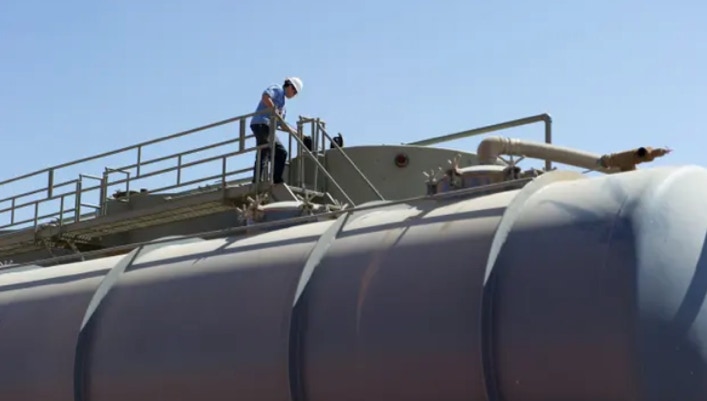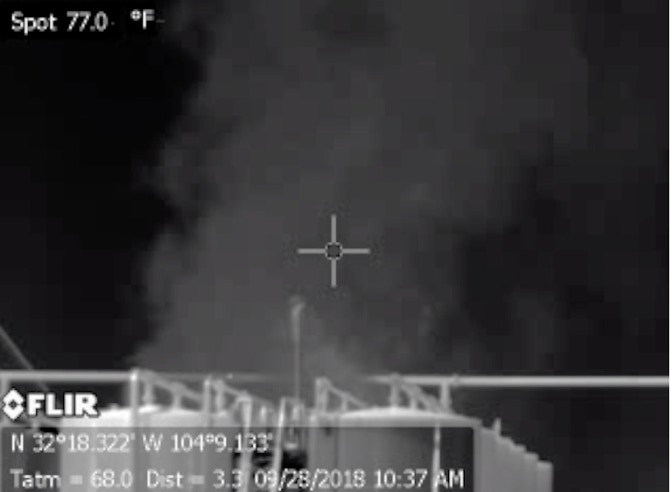Fossil Fuel Vapors Kill Workers
Fossil fuel workers are dying inhaling gases – despite US warnings to big oil
After multiple worker fatalities, the US government warned manual gauging was dangerous. The oil industry seems to have not taken note, activists say
This story is co-published with Drilled, a non-profit newsroom focused on climate accountability
Thu 13 Jul 2023 12.00 EDT
Jeff Springman climbed the metal stairs on an oil storage tank at a production site in west Texas and opened the small hatch at the top.
He was going to test the fluid in the tank before pumping it into his truck, a practice known as manual gauging. Instead he was engulfed by invisible chemicals that had built up inside.
Springman passed out.
A man he was training on the job that day in October 2019, Greg Fausto, caught him from falling several feet to the ground below, according to both men. When Springman came to, he saw that his gas monitor was beeping with a reading showing that the concentration of gas in the air had reached a flammable level.
He had a nosebleed and felt nauseous. “My mouth was caked with some kind of weird film,” Springman said. “Everything was just wrong.”
Springman, who was working for an oil and gas transport company called Pilot Transportation, hauling oil for Diamondback Energy, finished the job that day with Fausto’s help, but since then his health has deteriorated. He has cardiac arrhythmia, a known side-effect of breathing in hydrocarbon gases, as well as nervous system damage.
He has a blood clot in his lung that cannot be treated with blood thinners because of his ongoing gastrointestinal bleeding, according to medical records viewed by Drilled. “There’s nothing they can do for me,” Springman said. “If the blood clot leaves my lung and goes to my brain, I’m done.”
He’s not alone. After multiple worker fatalities related to manual gauging, the US government warned that the practice was dangerous. There were nine incidents of workers dying from inhaling gases while gauging tanks between 2010 and 2014, according to two government agencies. All of the workers died alone. Most of their bodies were found slumped over thief hatches at the top of storage tanks. But the oil industry seems not to have taken note. Since 2016, at least a dozen more workers have died as a result of manual gauging, though some experts think that is likely to be an undercount.
Sharon Wilson, a longtime environmental advocate who researches methane emissions, says she still sees workers manually gauging tanks in Texas all the time.
Wilson carries an optical gas imaging camera capable of viewing emissions coming off tanks, meaning she can see the gases that workers cannot. “When I see a worker opening a thief hatch” – the name for the hatch on top of a tank – “it can look like a volcano erupts”, as hydrocarbon gases spew out. “It’s terrifying because I know when I see a worker walking up the stairs, I know what they’re gonna do and I know that I could sit there on the side of the road and watch a worker die.”
Video shows emissions coming off an oil storage tank, as seen through an optical gas imaging camera. Courtesy of Sharon Wilson
The oil and gas industry is dangerous for its workers, with a fatality rate seven times higher than the national average, according to a 2013 study.
But the fatal risk of hydrocarbon vapors – gases like methane, propane and butane that build up in the air space of storage tanks – gained attention after the death of 21-year-old Dustin Bergsing in North Dakota in 2012. His death was originally chalked up to cardiovascular disease, but toxicology testing found propane and butane in his blood.
Dr Robert Harrison, an occupational medicine physician from the University of California, San Francisco, alerted the CDC’s National Institute for Occupational Safety and Health (NIOSH), and the Occupational Safety and Health Administration (Osha) of Bergsing’s death, as well as a second worker fatality in 2010 under similar circumstances. “These oil and gas vapors are breathed into the lungs and cross over very quickly into the blood,” Harrison said.
“If the breathing centers shut down, you don’t get enough oxygen into your body. Then you starve your heart of oxygen and the heart stops working. So that’s probably what happens in most of the cases.” The gases can also have a direct impact on the heart, sending it into fibrillation, he added.
Harrison was the lead author of the 2016 CDC study that attempted to tally worker deaths from exposure to gases and vapors released from thief hatches on tanks. The team found more deaths under similar circumstances that they did not count because the medical examiners in those cases did not perform toxic exposure testing. For this reason, it’s likely deaths related to hydrocarbon poisoning have been undercounted.
On 21 January 2022, a diesel transport driver performing duties similar to Springman was found dead in the cab of his truck. The cause of death in his case was determined to be cardiac arrest, like earlier cases identified by the Centers for Disease Control and Prevention. Cardiac arrest is one of the most common immediate reactions to acute exposure to hydrocarbon gasses.
In response to a 2016 Osha safety alert, the American Petroleum Institute (API) updated its best practices to include ways for oil and gas companies to lower the risk for workers during tank gauging, sampling and maintenance, said Stephanie Stevens, a spokesperson with National Institute for Occupational Safety and Health. To view those standards, one must pay API over $100. Recommendations include using electronic gauges that are capable of measuring fluid levels inside tanks and sending the information to a screen on site, which would allow workers to avoid opening thief hatches all together. Electronic gauges are now common on tanks on some federal land managed by the Bureau of Land Management, and on new tanks, but manual gauging remains a common practice on private land.
The government alerts were not followed by the passage of any laws regulating manual gauging or mandating remote gauging.
API did not respond to questions from Drilled/the Guardian about manual gauging but pointed to the work of the Tank Gauging Focus Group.
Federal agencies have continued to try to raise awareness of the fatal risk manual gauging poses to workers with safety videos and outreach to medical examiners and coroners about the need to test for toxins in the blood of workers who die on the job. Still, between 2016 to 2020, another 12 workers died while transferring oil and gas fluids at well sites, according to a public awareness video released in February by the CDC. Some of the workers died from cardiac events and others from explosions.
“Honestly, it is the most terrifying thing of all the horrors I’ve witnessed in the oilfield,” Wilson says. “I’ve been following it closely for a long time. More deaths have occurred since the Osha/CDC research and it’s senseless because there is an alternative practice that would save lives.”
Harrison, the lead author of the 2016 CDC study, was surprised to hear from Drilled that workers were still manually gauging through thief hatches on storage tanks since his work for the CDC showed the risks of the practice. “We obviously have more work to do,” he said.
Springman estimates that 95% of the Diamondback Energy sites he was sent to in Texas during his time working with Pilot Transportation required manual gauging. (Neither company responded to requests for comment.) He has filed a lawsuit against Diamondback for the illnesses he has endured since the incident at one of their sites in 2019.
“It needs to be mandatory that nobody ever goes on top of a tank,” Springman said. He believes fossil fuel companies have failed to install electronic gauging equipment to protect workers, despite knowing about the risk since at least 2016, because of the cost. Instead, workers like him pay the price. On 26 June 2023, Springman was diagnosed by MD Anderson Cancer Center in Texas with myelodysplastic syndrome, a blood cancer, caused by exposure to benzene, according to medical records seen by Drilled and the Guardian. His doctors have told him there is little they can do for him at this point.
For more than three years he has been in pain as various parts of his body have begun to fail. But what hurts Springman the most is the fact that his family, including his children, is being forced to watch his health continue to worsen. “For a human being to watch somebody rot and die, what is that price?”

